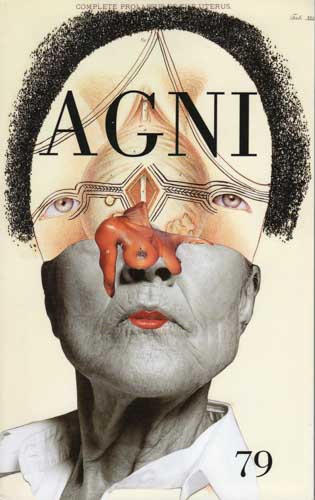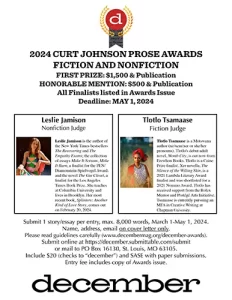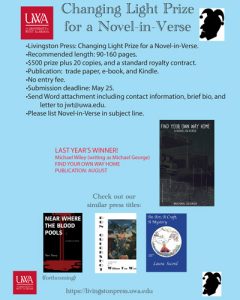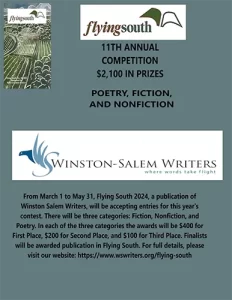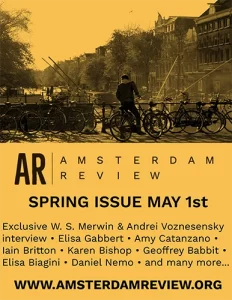AGNI – Number 79
Because Agni 79 begins with an editor’s note titled “Ten Broad Swipes at the Problem of Structure in the Essay (and Perhaps Other Genres as Well),” I first turned to the essays collected in the issue to see how they managed to meet Sven Birkerts’s argument for the arbitrariness of chronological structure. “As we all know,” Birkerts writes, “there is a huge difference between a narration that unfolds an experience in sequence (as they say in the movies, when the witness is being questioned, “Just start at the beginning”)…” Because Agni 79 begins with an editor’s note titled “Ten Broad Swipes at the Problem of Structure in the Essay (and Perhaps Other Genres as Well),” I first turned to the essays collected in the issue to see how they managed to meet Sven Birkerts’s argument for the arbitrariness of chronological structure. “As we all know,” Birkerts writes,
there is a huge difference between a narration that unfolds an experience in sequence (as they say in the movies, when the witness is being questioned, “Just start at the beginning”) and one that invents its own logistics, jumping to and fro, weaving hindsight perspectives in with accounts of original impressions, or else making a delicate or indelicate braid, alternating points of view and time-sequences in some strategically managed way.
Given that his rebellious introduction to the issue was a treatise on breaking traditional sequential narrative form—and given my own curiosity with the flexibility of the “lyric essay”—I was eager to see how Agni 79’s contributing essayists would manipulate structure.
The thirteen steps of a chess game executed by Mairead Small Staid in “Longing and Other Dimensions” explores Marcel Duchamp’s obsessive move from art to chess and his generation of artists’ absorption of relativity and a fourth dimension, jumping between numbered sections that relate notions and discoveries of Euclidean postulates, Jackson Pollack, John Cage, and Lewis Carroll’s Through the Looking Glass. “The story is a multidimensionable fable, a fairy tale played out within the space of a chessboard—a space which, in Carroll’s capable hands, proves as limitless as his imagination,” Staid successfully strategizes toward her checkmate.
“On Practice, School Buses, Hummingbirds, Rumi, and Being Led” by Carol Ann Davis marks the second segmented essay beyond the ten-part introduction and, in it, Davis indirectly weaves a tale of tragedy unspoken, noting in twenty-seven numbered sections a variety of moments of attention—to climbing into the wrong car as a child, to Rumi, to a motorboat’s distant “wub-wub,” to a hummingbird’s mistake, to the curve of the continental shelf—all avoiding the unwitnessed “terrible thing” involving a bus full of schoolchildren. Led through the moments of the unseen/unsaid, the reader can piece together the weightier subtexts: “I was also happily blind, momentarily without an eye to see them, unable to look for anything,” Davis writes.
Anna Journey’s “An Arrangement of Skin” is another example of juxtaposing time with stilling moments as widely varied and as intricately connected as a confession to a Houston area suicide hotline and observations made in a Parisian taxidermy museum. Journey quotes the poets Charles Simic (“The secret wish of all poetry is to stop time”) and Kathleen Graber (“The lyric moment is an eternal moment . . . What is more impossible, more desired, than that?”) and finally concludes, in reflection of the taxidermy peacocks and fox skeletons, “These specimens of stopped time were, I realized, transparent, undying . . . like an ark that carried me—carries all of us, our stories.”
Nicola DeRobertis-Theye’s “Things We Saw and Bought and Lost” is formatted as a list, presented as the things, places and peoples observed—“(t)he motorcycle, the saris, the blanket, the dupattas, the scooters”—that ultimately becomes an elegy for a friend in Delhi who dies from a presumed drug overdose. “We didn’t have Nick so we burned his costume,” she writes.
From DeRobertis-Theye’s list of items lost, the nonfiction continues with Elvis Bego looking for himself in “Lost in London.” Wandering through his memories and actual jottings from his London notebook, Bego meditates on the melancholy of isolation in a city Shelley compared to Hell.
Finally, as if providing the historical context of Carol Ann Davis’s annotation of writing around the subject avoided, William Eaton looks at several literary texts—focusing on Oscar Wilde’s The Importance of Being Earnest—in an analysis of what is omitted or unspoken “in works that attempt to say what has been going unsaid in the culture to which they respond.” In “The Unsaid,” Eaton writes, “The corollary proposition of this essay is that it is on account of the unsaid that some or perhaps many works have become ‘classics,’ speaking, however ironically, to generation after generation of dissimulating humans.”
The poetry of Brian Tierney, Kevin Prufer, Patricia Hooper, and others; the fiction by Megan Mayhew Bergman and Ann Pancake; the cover art and color gallery by Wangechi Mutu inside the issue Agni 79—all contribute to this fascinating exhibit of what editor Birkerts calls a structure of intelligence that is, quoting Joseph Brodsky, “self-propelled by form.”
[www.bu.edu/agni]

